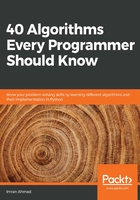
Tuples
The second data structure that can be used to store a collection is a tuple. In contrast to lists, tuples are immutable (read-only) data structures. Tuples consist of several elements surrounded by ( ).
Like lists, elements within a tuple can be of different types. They also allow complex data types for their elements. So, there can be a tuple within a tuple providing a way to create a nested data structure. The capability to create nested data structures is especially useful in iterative and recursive algorithms.
The following code demonstrates how to create tuples:
>>> bin_colors=('Red','Green','Blue','Yellow')
>>> bin_colors[1]
'Green'
>>> bin_colors[2:]
('Blue', 'Yellow')
>>> bin_colors[:-1]
('Red', 'Green', 'Blue')
# Nested Tuple Data structure
>>> a = (1,2,(100,200,300),6)
>>> max(a[2])
300
>>> a[2][1]
200
Wherever possible, immutable data structures (such as tuples) should be preferred over mutable data structures (such as lists) due to performance. Especially when dealing with big data, immutable data structures are considerably faster than mutable ones. There is a price we pay for the ability to change data elements in lists, for example, and we should carefully analyze that it is really needed so we can implement the code as read-only tuples, which will be much faster.
Note that, in the preceding code, a[2] refers to the third element, which is a tuple, (100,200,300). a[2][1] refers to the second element within this tuple, which is 200.